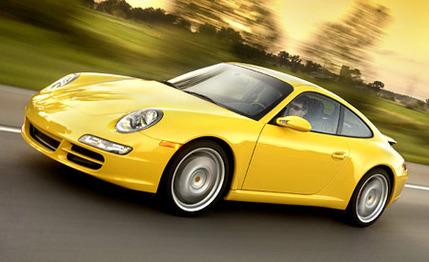
 Road Test
Road Test
Where does the Porsche 911 go from here? It's a fair question, considering this is the 97th article this magazine has published since 1965 about roadgoing 911s.
We've spun out in all the variants from the 912 to the shovel-nosed 930. We've twisted driveshafts in all the Carrera 4s. We've compared 911s to everything from Corvettes to De Loreans to motorcycles to airplanes. The best line ever published about a Porsche was in this very magazine in 1980, when P.J. O'Rourke called it an "ass-engine Nazi slot car."
So here, in story No. 97, a road test of the new "997" model, we gotta ask, "What's next?" This 2005 Porsche 911 Carrera S-the S denoting a 29-horsepower, $9800 upgrade over the base $70,065 rear-drive Carrera, or a breathtaking $85,910, as optioned here-is the best Carrera Porsche has ever built. The company achieved that partly through new technology but mainly by reversing the car back to better days of styling and attitude. If backward is better, has the 911 hit an evolutionary dead end?
The outgoing Porsche 911, codenamed the 996 (see stories 65 through 95), was supposed to be the best; faster, quieter, cleaner, more flexible, better built-the Swabian summit of ass-engine engineering. Launched in 1998, that first water-cooled 911 was all those things and a delight to drive. Both lap times and warranty items dropped with the 996 we drove over a 40,000-mile test, but the car just wasn't as fun as its frisky air-cooled predecessor. Many here considered the 996 colder, duller, more remote, and cheaper inside. It had less Porsche passion and more Toyota calculation. A team of retired Toyota execs was consulting for Porsche at the time of the 996's incubation. Coincidence?
Consider that of five comparison tests to which we subjected the 996, the Porsche lost all save one, where it was pitted against unworthy opponents: a Jaguar XKR and a Panoz Esperante. Porsche had modernized its derriere-engined darling right into a box, and the only way out, at least in some respects, was backward, with the return of a few Porsche 911 peculiarities that were lost in the last go-round.
Among the lost traits: the 911's sensuous shoulders and hips, restored by pulling in the waist and pushing out the track at both axles. The previous 911 looked slightly flaccid, as if one too many strudels had gone to its middle. A 911 has always stirred the blood with svelte, athletic curves stretched tight over large tires. This new Carrera, long-serving Porsche chief designer Harm Lagaay's final opus before retirement, does the stirring a bit better. It has nearly identical length and height dimensions as the outgoing 996 model's, but with its bigger behind, upright oval headlights, and slotted lenses for the front turn signals, it generates similar visual venom to the old air-cooled 993.
The reskin is subtle enough that only other 911 wing nuts will likely notice it at first glance. And the new 997 only appears slimmer. At 3290 pounds, this 2005 Carrera S is heavier than its predecessor by about 100 pounds. The standard 19-inch wheels and tires-the last Carrera offered standard 18s-are among the culprits.
In the cockpit Porsche has abandoned its fascination with rising dough forms. The lines are now as hard and straight as the stripes on the German flag, the dash is available with a long, low shelf of French-stitched leather (part of a $4825 leather package that was not on our test car). Its surfaces are firm and unyielding, the airbags artfully concealed as if time had stopped before the invention of the crash dummy. Thin blades of silver-painted plastic do the accenting around the vent grilles, and two minimalist cup holders, no doubt Nürburgring-tested with a Big Gulp, swing out from behind a narrow door pinched between the dash and glove box. The jet-intake door pulls provide the only real flourish.
Optional steering-wheel controls (for $990) aid the optically challenged and thick-fingered who try to operate the clusters of tiny buttons. At least the quintet of circles that form the gauges fan out in a wider, more handsome spread for easier viewing. A big tach takes the center, of course. The $920 Sport Chrono Package Plus parks a dual analog-digital stopwatch on the dash operated by a steering column lever. Memorize the dense manual in the pits before attempting the lap record. Was that "lever forward" for the lap split, or was it "down and back" to reset? Even with the chronograph's wart there, visibility forward improves, and the cockpit feels more spacious with the overall shrinking and retreating of the dash.